Publisher: Amy Marson Creative Director: Gailen Runge Editor: Liz Aneloski Technical Editors: Priscilla Read and Alison M. Schmidt Design Direction: Kristy Zacharias Cover Designer: Kristen Yenche Page Layout Artist: Casey Dukes Production Coordinator/Illustrator: Tim Manibusan Production Editor: Alice Mace Nakanishi Style photography: Page + Pixel Studio photography: Diane Pedersen, unless otherwise noted Published by C&T Publishing, Inc., P.O. Box 1456, Lafayette, CA 94549 Log Cabin Star Finished size: 36 31 This stunning Log Cabin table topper/wallhanging is made from two simple blocks with no set-in seams, so any level of quilter can make one. The blocks are created starting with a diamond or a triangle and then adding strips to the sides, in order. If you are unfamiliar with the concept of Log Cabin style, make one diamond block and one triangle block to see how simple it is. 
 60 Ruler This project requires a Clearview Triangle 60 Acrylic Ruler10 (from C&T Publishing).
60 Ruler This project requires a Clearview Triangle 60 Acrylic Ruler10 (from C&T Publishing).
The 10 is the perfect size for these blocks. If you already own the Clearview 8 or the Clearview Super 60, you can use them but will need to add another ruler when cutting the largest shape for each block. Caution:If you use another manufacturers 60 ruler, especially one with a flat top, youll need to adjust which ruler line is used.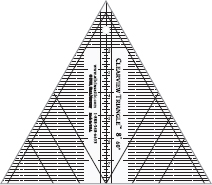 Fabric Selection If you look at these different samples, you will notice that for some, the star stands out dramatically; others have a pinwheel or a blossom in the middle. Here is how these special effects happen. For the star to stand out significantly, there has to be a high contrast in value between the star outline and the fabric behind it. The greater the difference in value, the more vivid the star.
Fabric Selection If you look at these different samples, you will notice that for some, the star stands out dramatically; others have a pinwheel or a blossom in the middle. Here is how these special effects happen. For the star to stand out significantly, there has to be a high contrast in value between the star outline and the fabric behind it. The greater the difference in value, the more vivid the star.
Figure A  Quilt by Amy Hart The light and medium in the center of the star, as designed by Sara, creates a pinwheel effect. Figure B
Quilt by Amy Hart The light and medium in the center of the star, as designed by Sara, creates a pinwheel effect. Figure B 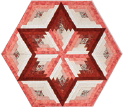 Quilt by Libby Smith If the values vary inward, you get a starburst effect. Figure C
Quilt by Libby Smith If the values vary inward, you get a starburst effect. Figure C  Quilt by Dot Kuffel Notice also that the chimneys can match either the star or the center. Coordinating with the star (Figure D), the center has more round appearance. If the chimney blends with the center, there is a secondary star pattern happening. Figure E
Quilt by Dot Kuffel Notice also that the chimneys can match either the star or the center. Coordinating with the star (Figure D), the center has more round appearance. If the chimney blends with the center, there is a secondary star pattern happening. Figure E 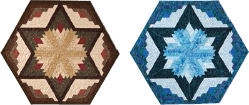 Quilts by Lynn McCamant (left)
Quilts by Lynn McCamant (left)
and Marci Baker (right) On the red and cream star, the quilter changed the values outside the star to create a chain of diamondsa wonderful Christmas table topper.
Figure F  Quilt by Sharon McNancy Cleary Knowing these subtleties, select your own fabrics, and create a unique design all your own.
Quilt by Sharon McNancy Cleary Knowing these subtleties, select your own fabrics, and create a unique design all your own.  Photos by Steve Hays MATERIALS Yardage is based on 42-wide fabric. Using the photos in the previous section and the diagrams that show the blocks in the finished quilt, decide where the colors and values will be in your project. The yardage given is for 17 different fabrics, as shown in the diagrams. Gather your choices based on yardages shown here.
Photos by Steve Hays MATERIALS Yardage is based on 42-wide fabric. Using the photos in the previous section and the diagrams that show the blocks in the finished quilt, decide where the colors and values will be in your project. The yardage given is for 17 different fabrics, as shown in the diagrams. Gather your choices based on yardages shown here. 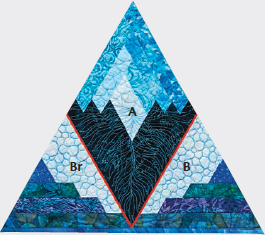 Placement of Diamond (A), Triangle (B), and Reverse Triangle (Br) NOTE All yardages provide enough fabric for an extra cut and shrinkage and straightening of the fabric except the yard. They do not allow for an extra cut.
Placement of Diamond (A), Triangle (B), and Reverse Triangle (Br) NOTE All yardages provide enough fabric for an extra cut and shrinkage and straightening of the fabric except the yard. They do not allow for an extra cut.
If you prefer that extra amount, increase all from to yard. DIAMOND (STAR) Chimney 1: yard Light 1: yard Light 2: yard Light 3: yard Medium 1: yard Medium 2: yard Medium 3: yard Dark 1: yard Dark 2: yard Dark 3: yard TRIANGLE (SURROUNDING STAR) Chimney 2: yard Light 4: yard Light 5: yard Light 6: yard Medium 4: yard Medium 5: yard Medium 6: yard FINISHING Corner fabric (optional): yard (for Optional: Squaring the Design) Backing: 1 yard Batting: 36 42 Binding: yard  Diamond color placement
Diamond color placement 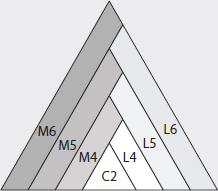 Triangle color placement CUTTING WOF = width of fabric Cut the strips listed below, noting that the chimney strips are cut to the width specified and all other strips are cut 1 WOF. DIAMOND (STAR) Chimney 1: 1 strip 2 WOF strips 1 WOF strips: Light 1: 1 strip Light 2: 1 strip Light 3: 2 strips Medium 1: 1 strip Medium 2: 1 strip Medium 3: 2 strips Dark 1: 2 strips Dark 2: 3 strips Dark 3: 3 strips TRIANGLE (SURROUNDING STAR) Chimney 2: 1 strip 2 WOF 1 WOF strips: Light 4: 1 strip Light 5: 2 strips Light 6: 3 strips Medium 4: 2 strips Medium 5: 2 strips Medium 6: 3 strips Diamond Block Cutting the Shapes Refer to the diamond block layout and the following instructions to cut the shapes and for piecing order. You need 6 of each shape to make the 6 diamonds in the project. As you cut the shapes, lay them out in this design, so you can see it come together. This will also make sewing each block together easier.
Triangle color placement CUTTING WOF = width of fabric Cut the strips listed below, noting that the chimney strips are cut to the width specified and all other strips are cut 1 WOF. DIAMOND (STAR) Chimney 1: 1 strip 2 WOF strips 1 WOF strips: Light 1: 1 strip Light 2: 1 strip Light 3: 2 strips Medium 1: 1 strip Medium 2: 1 strip Medium 3: 2 strips Dark 1: 2 strips Dark 2: 3 strips Dark 3: 3 strips TRIANGLE (SURROUNDING STAR) Chimney 2: 1 strip 2 WOF 1 WOF strips: Light 4: 1 strip Light 5: 2 strips Light 6: 3 strips Medium 4: 2 strips Medium 5: 2 strips Medium 6: 3 strips Diamond Block Cutting the Shapes Refer to the diamond block layout and the following instructions to cut the shapes and for piecing order. You need 6 of each shape to make the 6 diamonds in the project. As you cut the shapes, lay them out in this design, so you can see it come together. This will also make sewing each block together easier.  Diamond block layout CHIMNEY 1 Using a 2 strip, position the ruler at the right end of the strip, with one side along one edge of the strip.
Diamond block layout CHIMNEY 1 Using a 2 strip, position the ruler at the right end of the strip, with one side along one edge of the strip.
Cut the end of the strip to a 60 angle. Figure A 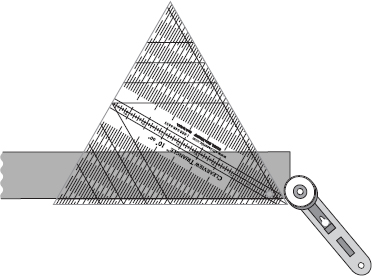 A Rotate the strip so the cut end is to the left. Place the ruler so the tip is at one edge of the strip, the 2 line (or the line the size of the diamond) is along the other edge, and the edge of the ruler is at the corner of the cut end. Figure B
A Rotate the strip so the cut end is to the left. Place the ruler so the tip is at one edge of the strip, the 2 line (or the line the size of the diamond) is along the other edge, and the edge of the ruler is at the corner of the cut end. Figure B 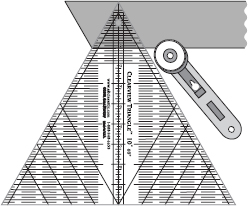 B Rotary cut only along the side opposite the first cut. (Check the size using the Chimney 1 pattern.) Continue moving the tool along the same side of the strip, lining up the cut edge and the side of the tool, as shown, to cut the required number of Chimney 1 pieces. DIAMOND LOGS (A.K.A. DIAMOND LOGS (A.K.A.
B Rotary cut only along the side opposite the first cut. (Check the size using the Chimney 1 pattern.) Continue moving the tool along the same side of the strip, lining up the cut edge and the side of the tool, as shown, to cut the required number of Chimney 1 pieces. DIAMOND LOGS (A.K.A. DIAMOND LOGS (A.K.A.
LONG DIAMOND) Diamond logs have a right leaning and left leaning shape. Check carefully to be sure you are cutting them in the direction required by the pattern.
Next page
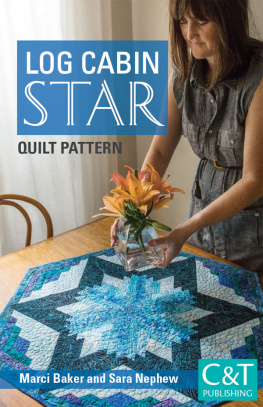
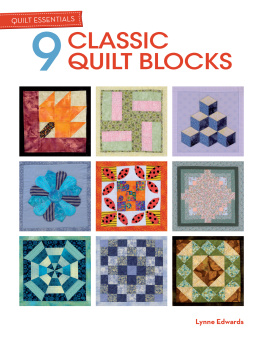
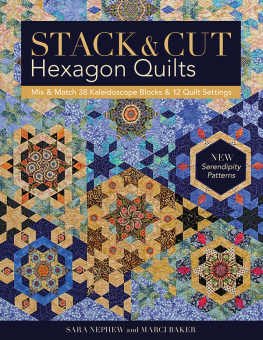

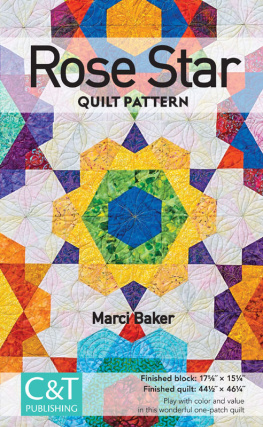

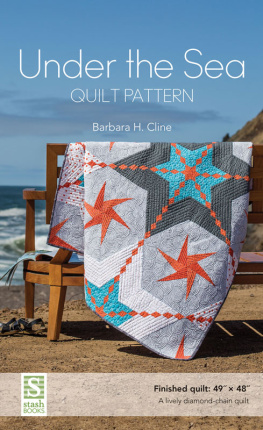
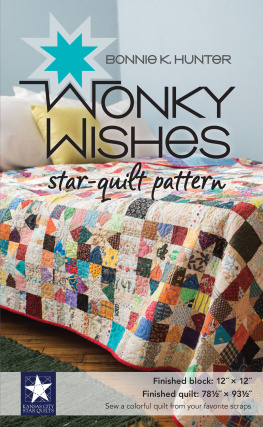
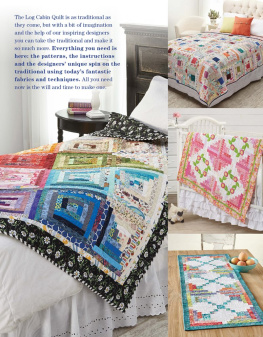
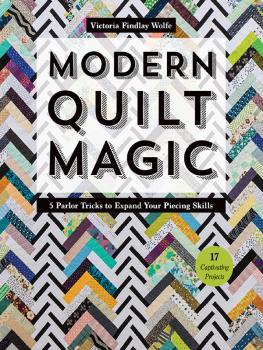


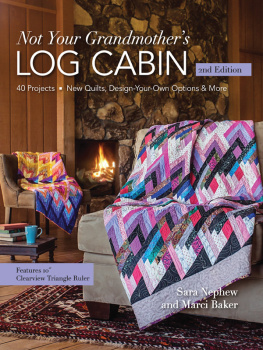

 60 Ruler This project requires a Clearview Triangle 60 Acrylic Ruler10 (from C&T Publishing).
60 Ruler This project requires a Clearview Triangle 60 Acrylic Ruler10 (from C&T Publishing). Fabric Selection If you look at these different samples, you will notice that for some, the star stands out dramatically; others have a pinwheel or a blossom in the middle. Here is how these special effects happen. For the star to stand out significantly, there has to be a high contrast in value between the star outline and the fabric behind it. The greater the difference in value, the more vivid the star.
Fabric Selection If you look at these different samples, you will notice that for some, the star stands out dramatically; others have a pinwheel or a blossom in the middle. Here is how these special effects happen. For the star to stand out significantly, there has to be a high contrast in value between the star outline and the fabric behind it. The greater the difference in value, the more vivid the star. Quilt by Amy Hart The light and medium in the center of the star, as designed by Sara, creates a pinwheel effect. Figure B
Quilt by Amy Hart The light and medium in the center of the star, as designed by Sara, creates a pinwheel effect. Figure B  Quilt by Libby Smith If the values vary inward, you get a starburst effect. Figure C
Quilt by Libby Smith If the values vary inward, you get a starburst effect. Figure C  Quilt by Dot Kuffel Notice also that the chimneys can match either the star or the center. Coordinating with the star (Figure D), the center has more round appearance. If the chimney blends with the center, there is a secondary star pattern happening. Figure E
Quilt by Dot Kuffel Notice also that the chimneys can match either the star or the center. Coordinating with the star (Figure D), the center has more round appearance. If the chimney blends with the center, there is a secondary star pattern happening. Figure E  Quilts by Lynn McCamant (left)
Quilts by Lynn McCamant (left) Quilt by Sharon McNancy Cleary Knowing these subtleties, select your own fabrics, and create a unique design all your own.
Quilt by Sharon McNancy Cleary Knowing these subtleties, select your own fabrics, and create a unique design all your own.  Photos by Steve Hays MATERIALS Yardage is based on 42-wide fabric. Using the photos in the previous section and the diagrams that show the blocks in the finished quilt, decide where the colors and values will be in your project. The yardage given is for 17 different fabrics, as shown in the diagrams. Gather your choices based on yardages shown here.
Photos by Steve Hays MATERIALS Yardage is based on 42-wide fabric. Using the photos in the previous section and the diagrams that show the blocks in the finished quilt, decide where the colors and values will be in your project. The yardage given is for 17 different fabrics, as shown in the diagrams. Gather your choices based on yardages shown here.  Placement of Diamond (A), Triangle (B), and Reverse Triangle (Br) NOTE All yardages provide enough fabric for an extra cut and shrinkage and straightening of the fabric except the yard. They do not allow for an extra cut.
Placement of Diamond (A), Triangle (B), and Reverse Triangle (Br) NOTE All yardages provide enough fabric for an extra cut and shrinkage and straightening of the fabric except the yard. They do not allow for an extra cut. Diamond color placement
Diamond color placement  Triangle color placement CUTTING WOF = width of fabric Cut the strips listed below, noting that the chimney strips are cut to the width specified and all other strips are cut 1 WOF. DIAMOND (STAR) Chimney 1: 1 strip 2 WOF strips 1 WOF strips: Light 1: 1 strip Light 2: 1 strip Light 3: 2 strips Medium 1: 1 strip Medium 2: 1 strip Medium 3: 2 strips Dark 1: 2 strips Dark 2: 3 strips Dark 3: 3 strips TRIANGLE (SURROUNDING STAR) Chimney 2: 1 strip 2 WOF 1 WOF strips: Light 4: 1 strip Light 5: 2 strips Light 6: 3 strips Medium 4: 2 strips Medium 5: 2 strips Medium 6: 3 strips Diamond Block Cutting the Shapes Refer to the diamond block layout and the following instructions to cut the shapes and for piecing order. You need 6 of each shape to make the 6 diamonds in the project. As you cut the shapes, lay them out in this design, so you can see it come together. This will also make sewing each block together easier.
Triangle color placement CUTTING WOF = width of fabric Cut the strips listed below, noting that the chimney strips are cut to the width specified and all other strips are cut 1 WOF. DIAMOND (STAR) Chimney 1: 1 strip 2 WOF strips 1 WOF strips: Light 1: 1 strip Light 2: 1 strip Light 3: 2 strips Medium 1: 1 strip Medium 2: 1 strip Medium 3: 2 strips Dark 1: 2 strips Dark 2: 3 strips Dark 3: 3 strips TRIANGLE (SURROUNDING STAR) Chimney 2: 1 strip 2 WOF 1 WOF strips: Light 4: 1 strip Light 5: 2 strips Light 6: 3 strips Medium 4: 2 strips Medium 5: 2 strips Medium 6: 3 strips Diamond Block Cutting the Shapes Refer to the diamond block layout and the following instructions to cut the shapes and for piecing order. You need 6 of each shape to make the 6 diamonds in the project. As you cut the shapes, lay them out in this design, so you can see it come together. This will also make sewing each block together easier.  Diamond block layout CHIMNEY 1 Using a 2 strip, position the ruler at the right end of the strip, with one side along one edge of the strip.
Diamond block layout CHIMNEY 1 Using a 2 strip, position the ruler at the right end of the strip, with one side along one edge of the strip. A Rotate the strip so the cut end is to the left. Place the ruler so the tip is at one edge of the strip, the 2 line (or the line the size of the diamond) is along the other edge, and the edge of the ruler is at the corner of the cut end. Figure B
A Rotate the strip so the cut end is to the left. Place the ruler so the tip is at one edge of the strip, the 2 line (or the line the size of the diamond) is along the other edge, and the edge of the ruler is at the corner of the cut end. Figure B  B Rotary cut only along the side opposite the first cut. (Check the size using the Chimney 1 pattern.) Continue moving the tool along the same side of the strip, lining up the cut edge and the side of the tool, as shown, to cut the required number of Chimney 1 pieces. DIAMOND LOGS (A.K.A. DIAMOND LOGS (A.K.A.
B Rotary cut only along the side opposite the first cut. (Check the size using the Chimney 1 pattern.) Continue moving the tool along the same side of the strip, lining up the cut edge and the side of the tool, as shown, to cut the required number of Chimney 1 pieces. DIAMOND LOGS (A.K.A. DIAMOND LOGS (A.K.A.